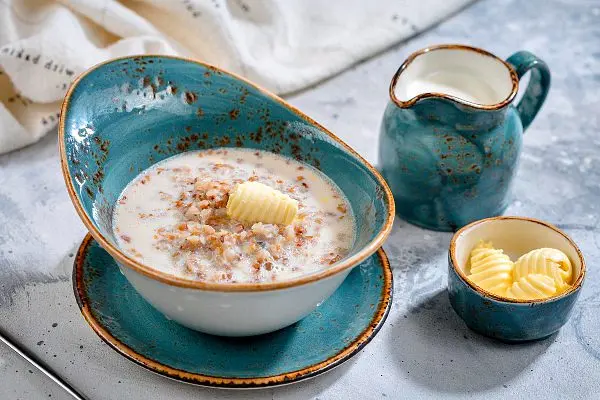Contents
😉 Greetings to everyone who cares about their health! Thank you for choosing the article “Buckwheat: benefits and harms to health” on this site.
What is buckwheat
Buckwheat (buckwheat, buckwheat, buckwheat, Siberian grouse, black rice) is a plant, cereal grain culture. Its seeds are used as food for humans, some animals and birds. Buckwheat is a wonderful honey plant, and dark buckwheat honey is a healing agent.
The homeland of buckwheat is India and Nepal. There they began to cultivate it 3000 years BC! Many centuries later, buckwheat appeared in China, Japan and Korea. In the XI century. she conquered European countries.
It is surprising that in Europe buckwheat is grown as a honey plant, and the seeds are sold in pharmacies as a medicine. Buckwheat porridge is popular in Russia, which is why Russia is the world’s largest buckwheat producer.
Buckwheat is an environmentally friendly food product, it has not been genetically modified. When growing it, no chemical fertilizers or pesticides are used. The plant is not afraid of weeds.
Buckwheat has two types:
- Green unground (not fried, “live”) costs twice as much as processed (brown).
- Brown (fried) kernel.

Unlike other cereals, buckwheat is stored for a long time, it will not turn rancid, and bugs will not start in it.
Buckwheat: calories
100 grams of buckwheat (unground) contains:
- 308 kcal;
- proteins – 10,8 g;
- fats – 3,2 g;
- carbohydrates – 56 g;
- Vitamins:
- A – 2 μg;
- B1 – 043 mg;
- B2 – 0,2 mg;
- B6 – 0,4 mg;
- B9 (folic acid) – 32 mcg;
- PP – 3,9 mg.
- Macro and microelements:
- phosphorus – 334 mg;
- iron – 8,3 mg;
- selenium – 8,3;
- molybdenum – 34,4 mcg;
- cobalt – 3,1 mcg;
- nickel – 10,1 mcg;
- titanium – 33 mcg;
- dietary fiber – 11 g;
- amino acids lysine (0,53 g) and methionine (0,32 g);
- rutin in the flowering part of the plant.
Buckwheat: benefits and harms to the body
This is a low-calorie and satisfying product. Buckwheat dishes are useful for everyone who controls their body weight and plays sports.
Buckwheat can replace meat in the human diet, but it is inferior to legumes. Regular consumption of buckwheat porridge has a positive effect on the metabolism in the body, stabilizes the work of the heart. Removes harmful toxins from the body.
- older people are recommended to include buckwheat in their diet (for constipation);
- pregnant women are advised to eat buckwheat (folic acid content);
- buckwheat honey, buckwheat porridge with beef liver – will help with anemia (anemia);
- with atherosclerosis, hypertension, scarlet fever, measles, a decoction is used;
- with rheumatism, hemorrhoids, arthritis, infusions and decoctions of buckwheat herb will help;
- buckwheat herb is an effective expectorant for dry cough;
- buckwheat raw materials are used to treat diseases of the blood vessels (the presence of rutin);
- treatment of purulent wounds (apply fresh leaves of the plant in the form of gruel);
- buckwheat porridge is suitable for patients with diabetes mellitus;
- powder from dried leaves serves as a dusting powder for diaper rash.
Is there any harm from buckwheat?
Buckwheat contains rutin. Therefore, it is not suitable for people with increased blood clotting.
It is undesirable to eat buckwheat with milk. The fact is that the body needs different enzymes to digest such food. The simultaneous consumption of milk and buckwheat can provoke diarrhea and indigestion.
Despite these restrictions, cereals should not be excluded from the diet. When consumed wisely, it will help in the functioning of all organs and systems of the body. Norm 150-200 gr. cereals per day.

Fresh flowers, stems and leaves of buckwheat are poisonous! They need to be dried before being consumed. Phagopirin, which is contained in the plant, has a toxic effect. But there are pluses: fresh grass is an excellent antiseptic and hemostatic when applied externally.
Buckwheat diet
Do you want to lose weight? Eat buckwheat! You don’t need to cook it! Pour the washed cereal (1 kg.) With boiling water (1,7 l.) And leave overnight in a sealed container. For a day, you need to eat everything in three to five meals (portion 200-250 gr.). Only porridge, no salt, oil and spices! Drink water or green tea.
Fiber, like a panicle, cleanses the intestines of toxins and removes excess water from the body. Useful elements and complex carbohydrates will keep you from feeling hungry. But the mono diet has its drawbacks. There is little fat in buckwheat, which is necessary for the skin and hair. Therefore, three to four days of buckwheat diet is enough to cleanse the body.
Recipe: buckwheat with kefir
The ratio of cereals and kefir is 1: 3. Pour the groats with skim or 1% kefir and place in the refrigerator overnight. Follow the diet for no more than 10 days with a break for a couple of weeks.
How to cook buckwheat porridge in water
Go through the buckwheat to remove plant debris and possibly small stones. Pour clean cereals with cold water and rinse until the water becomes clear. Place the washed buckwheat in a saucepan, cover with hot water.
The ratio of cereals and water is 1: 2. Then bring the water to a boil and remove the foam. Cook for 12-15 minutes. over low heat, covering the pan with a lid. Add butter to the porridge, wrap the pan and leave for 15 minutes.
Video
Do not miss! Here is additional information “Buckwheat: benefits and harms to health”.
😉 Friends, was this information useful to you? Subscribe to the newsletter of new articles to your mail. Fill out the form at the top right: name and email.









